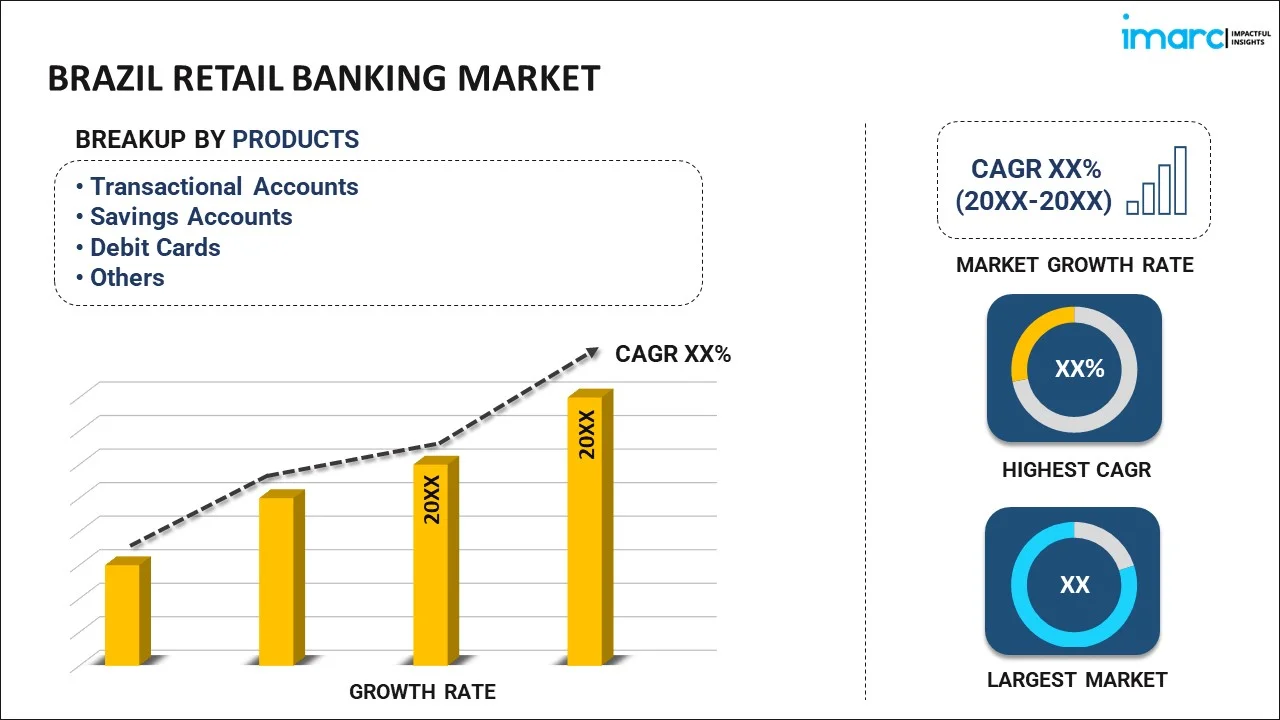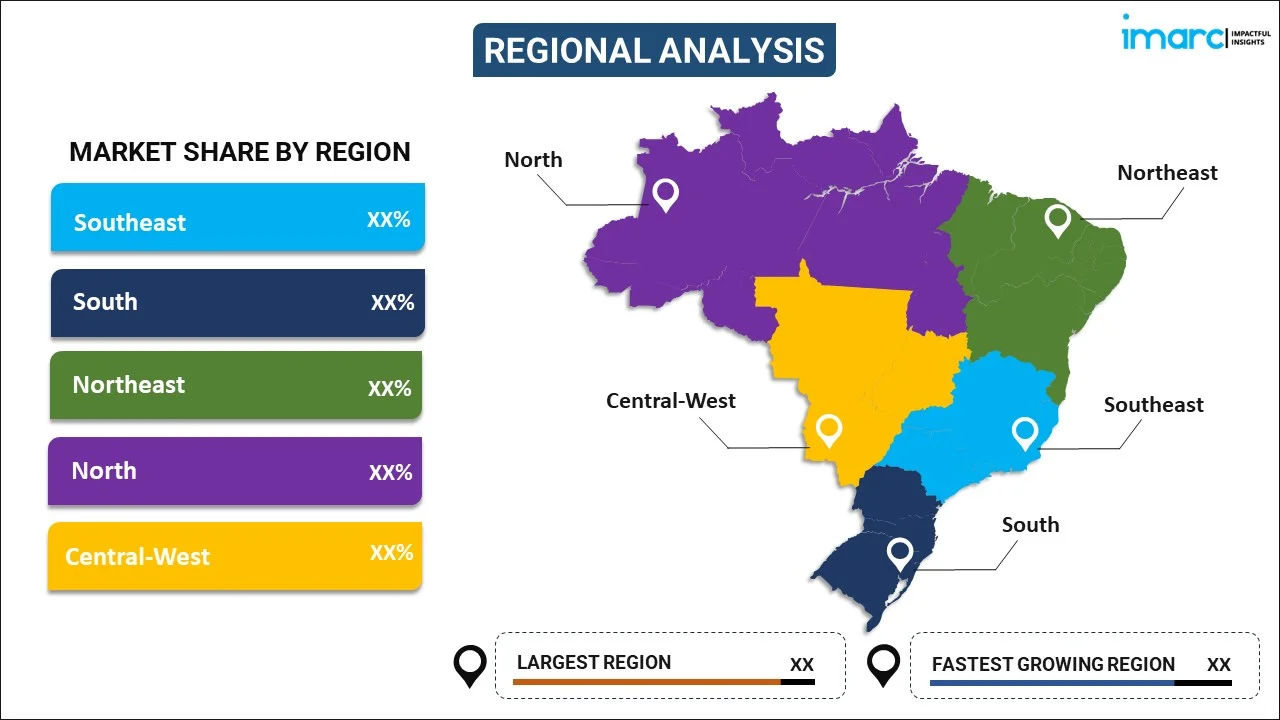
Brazil Retail Banking Market Report by Product (Transactional Accounts, Savings Accounts, Debit Cards, Credit Cards, Loans, and Others), Channel (Direct Sales, Distributor), and Region 2026-2034
Brazil Retail Banking Market Analysis:
Brazil retail banking market size reached USD 71.4 Billion in 2025. Looking forward, IMARC Group expects the market to reach USD 159.0 Billion by 2034, exhibiting a growth rate (CAGR) of 9.31% during 2026-2034. Rapid digitization, the escalating demand for customer-centric services, a rising middle-class population, government initiatives for financial inclusion, availability of low-interest rates, partnerships of key players with fintech firms, advancements in cybersecurity, and regulatory reforms are propelling the market growth.
|
Report Attribute
|
Key Statistics
|
|---|---|
|
Base Year
|
2025
|
|
Forecast Years
|
2026-2034
|
|
Historical Years
|
2020-2025
|
|
Market Size in 2025
|
USD 71.4 Billion |
|
Market Forecast in 2034
|
USD 159.0 Billion |
| Market Growth Rate 2026-2034 | 9.31% |
Retail banking, also known as consumer banking, is a sector of the banking industry that serves individual consumers rather than businesses or institutions. It offers a wide range of financial services that include savings and checking accounts, personal loans, credit cards, mortgages, and various other investment products like fixed deposits. The core function of retail banking is to accept deposits from customers and extend loans, thereby facilitating the flow of money within an economy. In terms of operations, retail banks generally have an extensive network of physical branches and ATMs. However, online banking services are becoming more common, giving customers access to transactions, payments, and account management from their devices. This shift has reduced reliance on in-person visits and improved access to banking in rural and underserved areas. Retail banking is easily accessible to the general public, providing a secure means for managing personal finances. It also serves as a cornerstone for economic development by encouraging savings and offering credit opportunities. The widespread presence of branches and automated teller machines (ATMs) ensures that banking services are available even in remote locations. Currently, various types of retail banking services exist to cater to specific needs: standard checking accounts for daily transactions, savings accounts for longer-term deposits, and specialized accounts, such as individual retirement accounts (IRAs) for retirement savings.
Brazil Retail Banking Market Trends:
AI-Driven Personalization in Retail Banking
Banks in Brazil are stepping up AI adoption to personalize user experiences, especially within digital interfaces. Algorithms track spending behavior to generate customized product offers, predict financial needs, and deliver alerts that help users avoid overdrafts or missed payments. Bradesco and Itaú Unibanco have embedded AI into their apps to enhance voice queries, automate budgeting insights, and create more intuitive customer interactions. This shift is reshaping how banks define user engagement. AI now plays a central role in fraud detection, loan risk assessment, and customer support. For banks to stay competitive, it’s no longer enough to offer standard digital access; they need intelligent systems that can anticipate and respond to client needs in real time. Many of these upgrades are now fully embedded in internet bank platforms, which have become testing grounds for personalized banking experiences powered by machine learning. Banks that integrate AI at the system level are also better positioned to launch financial planning tools and wealth products, especially as customer reliance on mobile banking services continues to rise in urban and rural areas alike.
Pix Reshaping Payments and Banking Habits
Pix has changed how Brazilians handle everyday transactions, replacing traditional payment methods with instant, cost-free transfers that work 24/7. Since its 2020 launch, it’s become the go-to option for consumers, businesses, and even government payments. Many retail outlets now accept Pix alongside cards and cash, while app-based usage has surged due to speed and simplicity.
Banks are building services around this behavior shift, offering cash-back promotions, loans tied to Pix activity, and onboarding tools for users with limited credit history. These innovations stem from the increasing role Pix plays in daily financial life, especially for small merchants and gig economy workers. Scheduled payments, offline transactions, and QR code enhancements are all part of the roadmap. With such widespread adoption, the Brazil Pix payment system is now a pillar of financial infrastructure, prompting both traditional and digital banks to rework product pipelines. As more features are added and usage diversifies, banks will likely see a greater share of their revenue tied to behaviors shaped by Pix, not just payment volume, but customer engagement across digital services.
Neobanks Pushing into the Mainstream
Neobanks have moved from niche players to major competitors in Brazil’s retail banking space. Brands like Nubank and Inter began by targeting younger users with zero-fee accounts and clean mobile experiences. Over time, they’ve gained traction among older segments, using social campaigns and in-app incentives to expand their base. These banks now offer credit lines, investment products, and bill payment systems, all within a single mobile app. Their success hinges on simplicity and speed. Real-time approvals, free transfers, and easy sign-ups have helped neobanks scale rapidly without the baggage of traditional infrastructure. Many are experimenting with alternative credit scoring methods and open finance APIs to give users more control and better rates. What started as a workaround to legacy systems has become a serious alternative. Today’s bank internet banking platforms are evolving to match the features pioneered by neobanks. But the challengers still have an edge in user experience, especially as demand for personalized tools and frictionless transactions grows.
Brazil Retail Banking Market Segmentation:
IMARC Group provides an analysis of the key trends in each segment of the market, along with forecasts at the country level for 2026-2034. Our report has categorized the market based on product and channel.
Product Insights:

- Transactional Accounts
- Savings Accounts
- Debit Cards
- Credit Cards
- Loans
- Others
The report has provided a detailed breakup and analysis of the market based on the product. This includes transactional accounts, savings accounts, debit cards, credit cards, loans, and others.
Channel Insights:
- Direct Sales
- Distributor
A detailed breakup and analysis of the market based on the channel have also been provided in the report. This includes direct sales and distributor.
Regional Insights:

- Southeast
- South
- Northeast
- North
- Central-West
The report has also provided a comprehensive analysis of all the major regional markets, which include Southeast, South, Northeast, North, and Central-West.
Competitive Landscape:
The market research report has also provided a comprehensive analysis of the competitive landscape in the market. Competitive analysis such as market structure, key player positioning, top winning strategies, competitive dashboard, and company evaluation quadrant has been covered in the report. Also, detailed profiles of all major companies have been provided.
Brazil Retail Banking Market News:
- In June 2025, Brazil’s central bank rolled out a new recurring payment feature for Pix, its instant payment system. Pix has dominated the country’s retail banking scene since its launch in 2020, now outpacing cash and cards. In 2024, Pix processed over 26 Trillion Reais (USD 4.61 Trillion) in transactions, cementing its role as the top payment method in Latin America’s largest economy.
- In December 2024, Pix had 172.6 Million users, roughly 75% of Brazil’s population, and handled 57 Billion transactions worth USD 3.8 Trillion that year. Its widespread adoption has reshaped the retail banking market, reducing reliance on cash and traditional transfers. Major banks like Itaú, Bradesco, and Banco do Brasil invested heavily in digital infrastructure, pushing over 80% of all banking transactions online in 2023, compared to just 54% in 2014.
Brazil Retail Banking Market Report Coverage:
| Report Features | Details |
|---|---|
| Base Year of the Analysis | 2025 |
| Historical Period | 2020-2025 |
| Forecast Period | 2026-2034 |
| Units | Billion USD |
| Scope of the Report | Exploration of Historical and Forecast Trends, Industry Catalysts and Challenges, Segment-Wise Historical and Predictive Market Assessment:
|
| Products Covered | Transactional Accounts, Savings Accounts, Debit Cards, Credit Cards, Loans, Others |
| Channels Covered | Direct Sales, Distributor |
| Regions Covered | Southeast, South, Northeast, North, Central-West |
| Customization Scope | 10% Free Customization |
| Post-Sale Analyst Support | 10-12 Weeks |
| Delivery Format | PDF and Excel through Email (We can also provide the editable version of the report in PPT/Word format on special request) |
Key Benefits for Stakeholders:
- IMARC’s industry report offers a comprehensive quantitative analysis of various market segments, historical and current market trends, market forecasts, and dynamics of the Brazil retail banking market from 2020-2034.
- The research report provides the latest information on the market drivers, challenges, and opportunities in the Brazil retail banking market.
- Porter's five forces analysis assist stakeholders in assessing the impact of new entrants, competitive rivalry, supplier power, buyer power, and the threat of substitution. It helps stakeholders to analyze the level of competition within the Brazil retail banking industry and its attractiveness.
- Competitive landscape allows stakeholders to understand their competitive environment and provides an insight into the current positions of key players in the market.
Key Questions Answered in This Report
The retail banking market in Brazil was valued at USD 71.4 Billion in 2025.
The Brazil retail banking market is projected to exhibit a CAGR of 9.31% during 2026-2034, reaching a value of USD 159.0 Billion by 2034.
Rising digital adoption, real-time payments (Pix), financial inclusion efforts, expansion of fintechs, regulatory modernization, growing middle-class credit demand, and banks’ focus on mobile-first services are reshaping Brazil retail banking market. Increased competition and consumer expectations are pushing traditional banks to innovate faster and diversify their offerings.
Need more help?
- Speak to our experienced analysts for insights on the current market scenarios.
- Include additional segments and countries to customize the report as per your requirement.
- Gain an unparalleled competitive advantage in your domain by understanding how to utilize the report and positively impacting your operations and revenue.
- For further assistance, please connect with our analysts.
 Request Customization
Request Customization
 Speak to an Analyst
Speak to an Analyst
 Request Brochure
Request Brochure
 Inquire Before Buying
Inquire Before Buying




.webp)




.webp)












